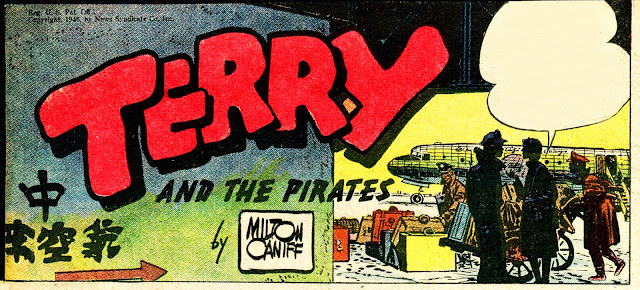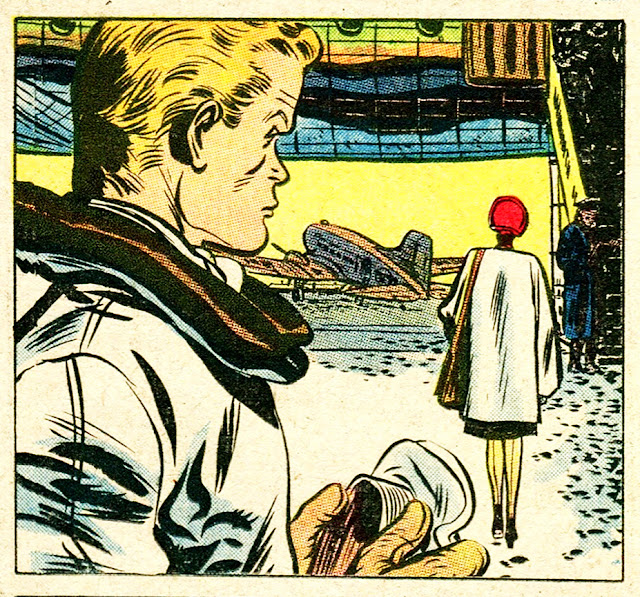Milton Caniff - The Final Terry and the Pirates Sunday Page - December 29, 1946
Milton Caniff ended his tenure on his Terry and the Pirates comic strip at the end of December 1946, before the syndicate turned the reins over the George Wunder, who continued the strip until February 25, 1973. Caniff's work on the strip was largely masterful, especially during the years in which he allowed Noel Sickles' approach to bleed into Terry, making that approach his own. The brush and ink use could often become Impressionistic, incorporating textures and heavy blacks to convey a depth and richness rarely found in the comics pages before that point. Caniff also used a great many cinematic approaches in Terry and the Pirates, changing viewpoints and grounds, and playing with depth of field with seeming ease. This cinematographic approach is seen in full in Caniff's final Terry and the Pirates Sunday page, which appeared on December 29, 1946. In the strip, Terry says goodbye to Jane Allen, while also saying goodbye to the strip itself. A brief bit of character background: Jane and Terry exhibit definite interest in each other over the latter course of Terry and the Pirates, but Jane is in love with a soldier nicknamed Snake, who has gone missing. She is given information which may lead to Snake's whereabouts, which is why she is leaving.
I've used this particular Sunday page in various comic strip and graphic narrative classes and workshops over the years, removing the text so that students could see how Caniff conveyed a sense of place, season, body language, emotions and action, without reading one word of the text. It is a master class in comic strip narration. The full image, with text, will be shown at the end. In the meantime, here is a panel-by-panel look at Milton Caniff's swan song:
The logo panel. It seems pretty simple and straight-forward at first glance, but there is a ton of information contained in this introductory panel. Even if one does not know the language, the viewer realizes, by the text on the wall at left, that the setting is in an Asian country. We see a plane in the background, so we know that this is taking place at an airport. There is snow on the ground, so we're all set on the season. And finally, the focus is on the two silhouetted figures. That's Terry on the left and Jane on the right. You can see Terry's flight uniform, so you know that he's in the service.
Moving on to panel two, the two characters are seen right up in the foreground, close together. It is obvious, given their proximity to each other, that they are not strangers. The body language and facial expressions conveys a seriousness in their mood. They are talking about something important.
In panel three, Caniff moves the camera to give us a bird's-eye view of the scene. This is a very text-heavy panel, yet Caniff is able to convey a good deal of space. We also notice the difference in the shape of the word balloon at the right, informing us that an announcement at the airport is being made. The contrast of the speaker and wall on the right sets that foreground space off beautifully against the lightness of everything behind it.
Jane and Terry say goodbye in a formal fashion in panel four. Shaking hands right in the middle of the panel, Jane is ramrod straight, while Terry is ever-so-slightly bent. It is a distant goodbye.
Panel five is a wordless one, with the camera set so that the viewer sees the scene from right behind Terry's shoulder. Caniff uses Terry's body to anchor the composition, while we see Jane walk to the plane, the texture of footprints in the snow ahead of her, leading the viewer's eyes. Take note of the height of the horizon line.
Panel six is also wordless, not only reversing the scene, but lowering the horizon line. Even though Terry is some short distance away from Jane, Caniff has set him up by her elbow. This allows Jane to look back without twisting her head all the way around. It also allows the viewer to see the sadness in her expression.
In panel seven, Caniff moves the camera once more to a bird's-eye view, adding a strong diagonal. The view is now from behind Terry again, but way up high. This allows Caniff to play beautifully with the footprints, as we can see Jane reverse course, to run back towards Terry. This panel has a muted color palette, but it needs no more. Every mark in this panel plays a part in conveying the scene.
Panel eight presents a very different type of goodbye from panel four. It's all about emotion and body language, emphasized by Caniff's changing of the contrast from back-to-front. The darkness pushes the figures far forward, right up to the front of the picture plane. It is a centered but dynamic composition, which is often not easy to pull off.
In panel nine, Jane has broken the embrace and runs towards the plane. We, as the viewer, are standing just behind the figure on the right, who beautifully frames the panel. Caniff's use of the diagonal space helps convey a deep space, with lots of layering.
Panel 10 switches the view yet again, from right behind Terry, as he waves goodbye to Jane's plane. The figure with the snow shovel is a minor character, but he helps anchor that lower right corner. He watches the plane just like us.
In the final panel, Caniff once again uses the footprints in the snow to convey movement and direction. The foreground is set in shadow, as Terry walks into the light, away from the viewer, and away from the comic strip. Caniff's message on the New Year's poster on the wall says it all: "Ring Out the Old. Ring in the New." The strip would no longer be in Caniff's hands after this.
And here is the full strip with the text. The text certainly adds richer context to the narrative, but Caniff is able to convey his intent without the words. As I said above, it is a master class in storytelling. We will revisit Caniff again at some point, looking at another one of his master classes: the first Steve Canyon Sunday page.
I've used this particular Sunday page in various comic strip and graphic narrative classes and workshops over the years, removing the text so that students could see how Caniff conveyed a sense of place, season, body language, emotions and action, without reading one word of the text. It is a master class in comic strip narration. The full image, with text, will be shown at the end. In the meantime, here is a panel-by-panel look at Milton Caniff's swan song:
Moving on to panel two, the two characters are seen right up in the foreground, close together. It is obvious, given their proximity to each other, that they are not strangers. The body language and facial expressions conveys a seriousness in their mood. They are talking about something important.
In panel three, Caniff moves the camera to give us a bird's-eye view of the scene. This is a very text-heavy panel, yet Caniff is able to convey a good deal of space. We also notice the difference in the shape of the word balloon at the right, informing us that an announcement at the airport is being made. The contrast of the speaker and wall on the right sets that foreground space off beautifully against the lightness of everything behind it.
Jane and Terry say goodbye in a formal fashion in panel four. Shaking hands right in the middle of the panel, Jane is ramrod straight, while Terry is ever-so-slightly bent. It is a distant goodbye.
Panel five is a wordless one, with the camera set so that the viewer sees the scene from right behind Terry's shoulder. Caniff uses Terry's body to anchor the composition, while we see Jane walk to the plane, the texture of footprints in the snow ahead of her, leading the viewer's eyes. Take note of the height of the horizon line.
Panel six is also wordless, not only reversing the scene, but lowering the horizon line. Even though Terry is some short distance away from Jane, Caniff has set him up by her elbow. This allows Jane to look back without twisting her head all the way around. It also allows the viewer to see the sadness in her expression.
In panel seven, Caniff moves the camera once more to a bird's-eye view, adding a strong diagonal. The view is now from behind Terry again, but way up high. This allows Caniff to play beautifully with the footprints, as we can see Jane reverse course, to run back towards Terry. This panel has a muted color palette, but it needs no more. Every mark in this panel plays a part in conveying the scene.
Panel eight presents a very different type of goodbye from panel four. It's all about emotion and body language, emphasized by Caniff's changing of the contrast from back-to-front. The darkness pushes the figures far forward, right up to the front of the picture plane. It is a centered but dynamic composition, which is often not easy to pull off.
In panel nine, Jane has broken the embrace and runs towards the plane. We, as the viewer, are standing just behind the figure on the right, who beautifully frames the panel. Caniff's use of the diagonal space helps convey a deep space, with lots of layering.
Panel 10 switches the view yet again, from right behind Terry, as he waves goodbye to Jane's plane. The figure with the snow shovel is a minor character, but he helps anchor that lower right corner. He watches the plane just like us.
In the final panel, Caniff once again uses the footprints in the snow to convey movement and direction. The foreground is set in shadow, as Terry walks into the light, away from the viewer, and away from the comic strip. Caniff's message on the New Year's poster on the wall says it all: "Ring Out the Old. Ring in the New." The strip would no longer be in Caniff's hands after this.
Here is the full wordless version of the Sunday page, in half-page format.
And here is the full strip with the text. The text certainly adds richer context to the narrative, but Caniff is able to convey his intent without the words. As I said above, it is a master class in storytelling. We will revisit Caniff again at some point, looking at another one of his master classes: the first Steve Canyon Sunday page.














Comments
Post a Comment